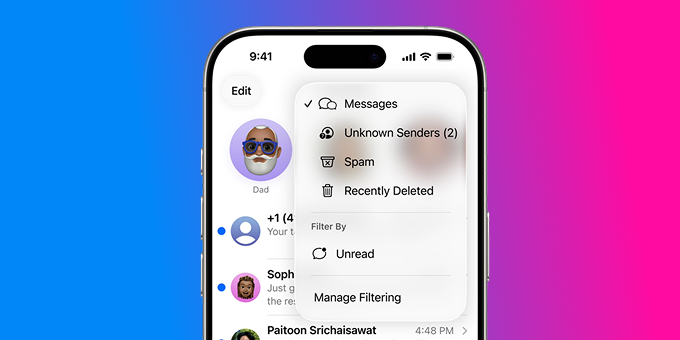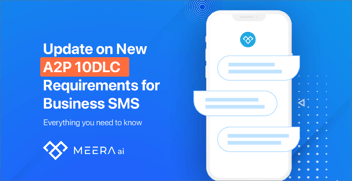What iOS 26 & Android Filtering Mean for SMS Marketing (And How To Adapt)

Apple’s iOS 26, launching publicly in fall 2025, introduces new message filtering rules that could reshape how business texts reach (or don’t reach) their audience. Android, meanwhile, continues to refine its own message categorization tools in Google Messages, with quiet filtering already affecting some branded SMS.
If your business relies on texting leads—whether for appointment reminders, quote follow-ups, or re-engagement campaigns—this isn’t a minor update. It’s part of a larger shift toward user-controlled communication ecosystems. And it has real implications for how, when, and whether your messages are seen.
Let’s break down what’s changing, why it matters, and how to adapt.
The New Rules of SMS Visibility
The update most likely to affect businesses is iOS 26’s filtering of unknown senders. If your number isn’t saved in the recipient’s contacts, your message may now land in a dedicated “Unknown Senders” tab inside the Messages app. Notifications for these texts are silenced by default, unless categorized as "Time Sensitive" or tied to authentication purposes (like verification codes).
Users can also customize alerts by message type: Transactions, Promotions, Personal, or Time Sensitive. In practice, that means a legitimate follow-up text from a business might not trigger any alert at all—especially if it’s grouped under Promotions.
Timeline of Mobile Filtering Capabilities
Apple (iOS):
- iOS 16 (2022): Introduced notification layout controls (Count, Stack, List).
- iOS 17.2 (Dec 2023): Added support for custom notification sounds.
- iOS 26 (Fall 2025): Expands message categorization and moves unknown senders into a filtered tab, muting alerts unless explicitly marked high priority.
Android:
- Android 8.0 (2017): Introduced Notification Channels for app-level control.
- Android 10+ (2019–2021): Added silent notifications, Do Not Disturb refinements, and per-conversation priorities.
- Google Messages (current): Actively filters texts from unknown or spammy sources into a separate tab with no alerts.
In both ecosystems, the trend is clear: platforms are doing more to prevent unwanted messages from interrupting users—and businesses must work harder to be recognized and welcomed.
Why This Is a Signal, Not Just Noise

It’s easy to view these updates as just another round of platform housekeeping—new filters, new hurdles. But that misses the bigger shift underway.
This isn’t about stopping spam. It’s about redefining what counts as worthy communication.
1. Compliance Doesn’t Guarantee Delivery
Carrier-level compliance (like registering campaigns under A2P 10DLC) is necessary—but it’s no longer sufficient. Even when your message is technically allowed, device-level controls may still filter or mute it.
Why? Because these controls are based on user behavior, not just content legality.
2. Recognition Is the New Deliverability
The biggest differentiator now isn’t just whether a message can be sent—it’s whether a user recognizes and trusts it:
- Is the sender clearly identified?
- Does the content feel expected or out of place?
- Is the message tied to a recent user action?
Messages from unsaved numbers—even relevant ones—are increasingly routed to a digital side room with the door shut.
3. Inbox Access Must Be Earned
Marketers now have to think like guests, not broadcasters. If you want to show up in the main inbox (with notifications turned on), your message must:
- Be clearly relevant to the user’s recent behavior
- Come from a recognizable sender
- Deliver value in the first few words
The burden is no longer just on “sending responsibly.” It’s about creating messages that are trusted, expected, and welcomed.
How to Adapt to the New Messaging Landscape
Here are practical steps to improve message visibility—whether you’re sending one-to-one follow-ups or scaled outreach via platforms like Twilio:
Lead with Recognition
Open with the business name and reason for contact, ideally referencing a recent user action.
Example:
“Hi Taylor, it’s Greenlight Energy—just following up on your solar quote request yesterday.”

Encourage Contact Saving
Prompt users to save your number after the first message. This can significantly improve inbox placement and ensure future alerts are seen.
“To avoid missing future updates, save this number as ‘Greenlight Energy’ in your contacts.”

Use Consent-Driven Messaging
Only send SMS to users who have taken an action—requested a quote, booked a call, filled out a form. Cold texting or third-party lists are not just risky—they’re more likely to be ignored or flagged.
Keep It Tight and Useful
Avoid overly promotional language or messages that feel like ads. Focus on service, updates, or helpful next steps tied to the user’s original inquiry.
Set Expectations at Opt-In
Make it clear on your site or form that the user will receive a follow-up via SMS. This tiny shift—setting the expectation—makes a big difference in response rates and filter avoidance.
A Case Study in High-Trust Messaging: Meera’s Approach
Meera.ai, an AI-powered SMS platform used by enrollment teams, financial service providers, and agencies, has been navigating these shifts head-on. Rather than relying on volume or promotional blasts, the platform is designed around timely, expected communication—with a few principles that stand out:
- Only engages with leads who have already opted in through form submissions, quote requests, or inbound actions.
- References specific details from the user’s interaction to signal legitimacy (e.g., “You asked about our life insurance options yesterday”).
- Builds human-like conversation flows that feel like actual back-and-forth, not robotic pings.
- Actively tests contact card prompts and A/B message formats to improve inbox placement under new iOS and Android rules.
The result? Even in highly filtered environments, Meera has driven significantly higher connect rates compared to email or outbound dialing—particularly for “aged leads” or hard-to-reach segments.
Final Takeaway
Message filtering is no longer just about catching spam—it’s about protecting attention. Mobile platforms are evolving to reflect user preferences, and that means marketers must evolve too.
The path forward isn’t blasting more messages. It’s crafting smarter, more relevant, and more respectful ones—designed to be recognized, not ignored.
In this new landscape, visibility is earned. And the businesses who prioritize clarity, consent, and context will be the ones that continue to connect.


.png?width=512&height=512&name=guru%20(1).png)

.png?width=199&height=109&name=salesforce-logo1-removebg-preview%20(1).png)


.webp?width=716&height=569&name=banner-img%20(1).webp)



